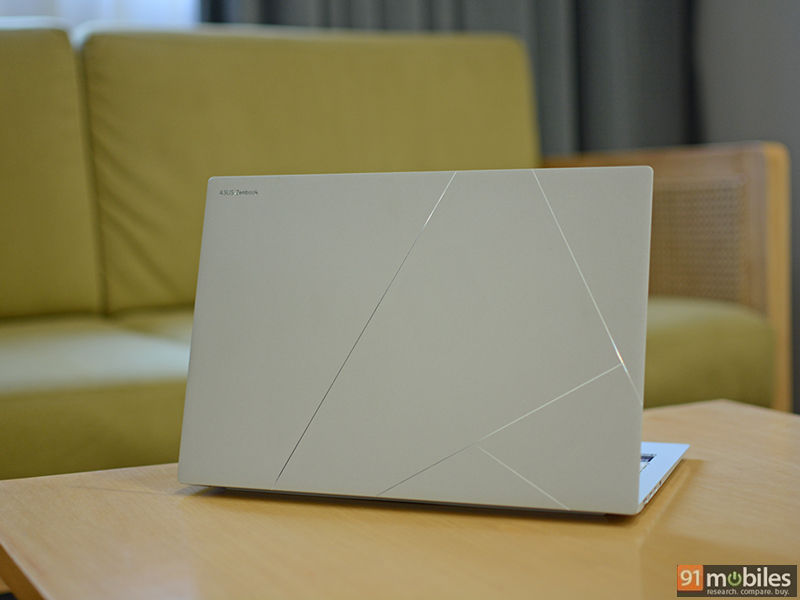ASUS has consistently positioned its Zenbook series as premium ultrabooks that blend elegant design with reliable performance. The latest Zenbook S 14 (2024) takes this vision further. It is one of the slimmest ultrabooks in its class and features Intel’s new Core Ultra Series 2 processor based on the Lunar Lake architecture, that aims to deliver power efficiency and performance tailored for thin and light notebooks.
With the new Zenbook S 14, ASUS is aiming to cater professionals, creators, and enthusiasts who need high performance in a compact, lightweight form. This notebook also stands as a crucial product for ASUS as it sets the precedent for next-gen mobile chips from Intel.
Here’s an in-depth look at the latest ultra slim flaghip.
Design
The Zenbook S 14 continues ASUS’s tradition of sleek and premium design. It is super compact, weighing around 1.2kg and measures just 0.5 inches thick, making it easy to slip into a bag for daily commutes or travel. Despite the lightweight design, the build quality feels sturdy. There’s very little flex on the lid, while the hinge and keyboard deck feel solid thanks to the all-aluminium build.

The lid is particularly interesting as it features a soft matte finish called “Ceraluminum”, a unique blend of aluminium and ceramic. You also get some angular lines across the lid, similar to the previous generation models, giving the laptop its distinguished look.


The “Scandinavian White” finish on the unit sent to us looks elegant and is a great option if you want to avoid fingerprints. But if you prefer something darker, ASUS is also offering the laptop in “Zumaia Gray.” Another unique design element of the new Zenbook S 14 is the geometric grille design right above the keyboard. Having 2,715 CNC machined perforations, this acts as a cooling vent allowing the CPU fans to pull fresh air enhancing cooling capability.


For a laptop that’s half an inch thick, I wasn’t expecting much in the I/O department. However, apart from the two USB Type-C Thunderbolt ports, there’s a 3.5mm audio jack, a USB 3.2 Gen 2 Type-A port and even a full-size HDMI 2.1 port. For wireless connectivity, there’s Bluetooth 5.4 and tri-band Wi-Fi 7 making the ZenBook S 14 one of the very few laptops in India to offer these next-gen wireless technologies.
Unfortunately, I didn’t have enough time with the review unit to open the bottom lid. However, from what I have seen at demos and previews in the past, the RAM and Wi-Fi card are both soldered onto the mainboard. Of course, the M.2 SSD is user-replaceable, as is the battery unit.
Display
One of the standout features of the Zenbook S 14 is its vibrant 14-inch Lumina 3K (2,880 x 1,800) resolution OLED display, which ASUS offers in both touch and non-touch variants. The display delivers deep blacks and rich contrast making it excellent for most use cases.
The panel also covers 100 percent of the DCI-P3 and sRGB colour spaces, has Pantone certification, DisplayHDR True Black 500 certification, and 500 nits peak brightness. In SDR though, the brightness is limited to just under 400 nits, which is still quite good. Considering all these features, the Zenbook S 14 is suitable for professional content creation.

The display is also fast and responsive thanks to the 0.2ms response time and 120Hz refresh rate. This results in a buttery smooth experience across the operating system. There’s also support for dynamic refresh rate, which is helpful for saving on some battery.
Overall, the visual experience is very well-balanced. The colours look great and punchy, the images are sharp and everything feels very fluid. There are various options to customize the display as per your liking via the MyASUS app including colour profiles, colour temperature, as well as features like OLED protection, flicker-free dimming, and more.
Keyboard and trackpad
ASUS has equipped the Zenbook S 14 with a backlit keyboard that offers a comfortable typing experience. The keys have a decent amount of travel, considering the laptop’s slim profile, and provide satisfying feedback for prolonged typing sessions. The keyboard layout is well-spaced too, with each key properly positioned for easy typing, making it suitable for both casual and professional use.

The trackpad is large and responsive, supporting multi-touch gestures on Windows. ASUS has also incorporated additional gestures into the trackpad where you can swipe on the right, left, and top edges to control different functions like screen brightness, volume, and seek media.
Performance
The Zenbook S 14 is powered by Intel’s Core Ultra Series 2 processor, specifically the Core Ultra 7 258V. This latest mobile CPU is a noticeable departure from its predecessor, featuring four P-cores (Performance) and four E-cores (Efficiency) compared to the six P-cores and 10 E-Cores on the Core Ultra 7 155H. It also doesn’t include hyperthreading which is said to help reduce overall power consumption. As per Intel, the Core Ultra 7 258V and has a rated TDP of 28W, although it can go as much as 37W on this particular laptop.
The CPU also features an improved NPU (Neural Processing Unit) compared to the previous-gen Meteor Lake CPUs, capable of up to 47 TOPS (Tera Operations Per Second). Additionally, the updated Intel Arc 140V integrated graphics solution brings a noticeable bump in GPU-related tasks. For memory you get integrated 32GB of LPDDR5X RAM clocked at 8533MT/s and for storage there is 1TB M.2 NVMe PCIe 4.0 SSD which is capable of up to 5,000MBps read and 3,500MBps write speeds, which is sufficient for most users.

Using the Zenbook S 14 for about two weeks I was quite satisfied with the balanced blend of performance and efficiency. The new Core Ultra processor utilizes Intel’s Lunar Lake architecture, which is optimised for power savings without compromising speed. This processor offers adequate performance, especially for multitasking and handling moderate to heavy workloads. It is also well-suited for users running applications like Adobe Creative Suite, handling spreadsheet-intensive tasks, or multitasking with multiple applications open.
Having said that, the CPU is a mixed bag when it comes to synthetic benchmark scores. Comparing the performance to the previous-gen Meteor Lake chip, the Core Ultra 7 155H, it falls behind in multi-core performance tests which is primarily due to the lower core count. The difference is not by a huge margin, so you may not notice that in everyday usage.

The onboard graphics solution is where Intel’s Lunar Lake shines. The Arc 140V comes with eight Xe cores which provide decent power for casual gaming and graphics-intensive tasks without a discrete GPU. The Zenbook S 14 is clearly not meant for gaming, but that does not mean that it isn’t capable. In GTA V with settings set to High and resolution at 1080p, I recorded average frame rates of 78FPS while Apex Legends at 1080p low was consistently above 85FPS, sometimes going upwards of 100FPS. Of course, while it doesn’t match the power of a dedicated graphics card for high-end gaming or 3D rendering, it performs impressively for an iGPU.
Thermal management is a critical aspect of ultrabook design, especially when packing a powerful processor into such a thin chassis. ASUS has equipped the Zenbook S 14 with a dual-fan cooling system paired with an ultra-slim vapour chamber sandwiched between two bi-layer graphite sheets. This effectively manages heat under typical workloads. The fans are relatively quiet, even during multitasking with a number of apps, which is crucial for users who rely on a quiet environment. They do ramp up when you enable the Full-speed mode (via MyASUS) for high-CPU or GPU usage tasks like rendering or gaming, but noise levels are fairly well maintained.

Under extended heavy usage, the laptop does get warm at the rear, but it remains comfortable for typing and general use. ASUS’s thermal design keeps the laptop’s performance steady, avoiding significant thermal throttling even during prolonged productivity sessions.
Other important features include the 1080p webcam with IR for Windows Hello and presence detection. It offers good clarity for video calls along with solid microphone performance. While the face recognition works well and is great for quickly logging into Windows, I was also quite pleased to use the presence detection feature that can either dim or put the laptop to sleep when you are away from your desk. This is a great way to conserve battery life as well.
The quad-speaker system (which includes two tweeters, and two woofers) is also worth mentioning. Considering how slim the chassis is, the audio performance is impressive with a good amount of bass and clarity. I haven’t done a direct comparison with a latest-gen MacBook, but overall the sound quality is right up there, especially for its category.
Battery Life
Battery life is one of the Zenbook S 14’s strongest features, thanks to the efficiency gains from Intel’s Lunar Lake-based Core Ultra Series 2 processor. ASUS claims that it can last up to 27 hours on a single charge in a 1080p video playback scenario. The laptop offers a 72Wh battery that, in our testing, lasts up to 10-12 hours of moderate use on a single charge. This makes it an ideal choice for professionals who need a reliable device that can last through a full workday without constantly hunting for a power outlet.

Charging is convenient with the included 65W USB-C charger, which supports fast charging, bringing the battery up to around 60 percent in about 50 minutes. This quick top-up capability makes the laptop even more portable-friendly for users who might need a quick charge between meetings or while on the go.
Testing it further with PCMark 10’s video battery benchmark and screen brightness set to 80 percent, the laptop scored 15 hours and 36 minutes, which is realistically the maximum amount of juice that you should expect from this laptop.
Verdict
The ASUS Zenbook S 14 with Intel’s Core Ultra Series 2 processor stands out as a sophisticated, powerful ultrabook that offers more than just good looks. It excels in essential areas like display quality, keyboard comfort, and battery life, making it a versatile tool for professionals, creators, and students alike. The OLED display is particularly impressive for those who require high colour accuracy and contrast, along with a fast a snappy response thanks to the high refresh rate and response time.
The Core Ultra 7 258V processor ensures performance suitable for daily multitasking and professional applications. While the integrated Arc 140V graphics are sufficient for casual graphics workloads, users looking for serious gaming or GPU-heavy creative tasks might still prefer a machine with a dedicated GPU. Additionally, while thermals are managed well, heavy sustained workloads might introduce some warmth, though the fans remain unobtrusive.
Overall, the Zenbook S 14 is an impressive laptop that combines premium build quality with the latest in processing technology. It’s an ideal choice for users who want an elegant, powerful, and highly portable laptop that doesn’t compromise on essential features. For those needing a powerful workhorse in an ultraportable form factor, the Zenbook S 14 offers excellent value, positioning itself as a strong contender in the ultrabook market.
Editor’s Rating: 8 / 10
Pros:
- Sturdy ultra-thin chassis
- Sharp and vivid OLED display
- Best in class battery life
- Impressive onboard graphics
- Excellent speakers
Cons:
- Slightly lower multi-core performance
- Premium price
img[data-m=”true”] {
display: none; visibility:hidden !important; height:0px;
}
The post ASUS Zenbook S 14 2024 review: a solid foundation for Intel’s latest Lunar Lake processors first appeared on 91mobiles.com.











